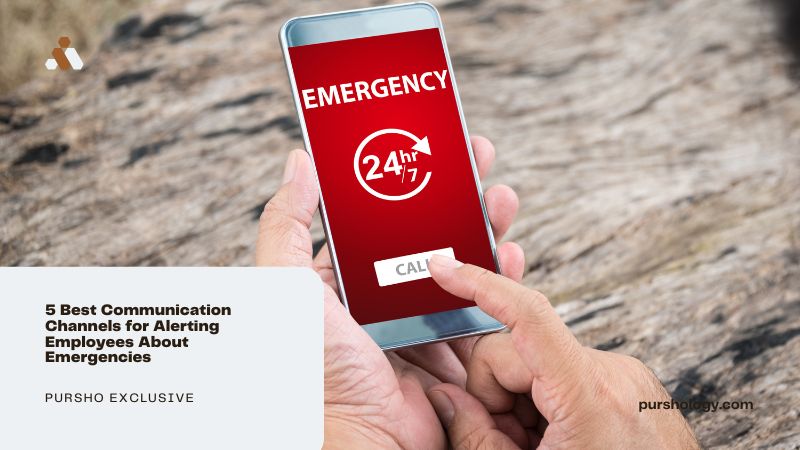The report “The State of Employee Safety in 2023” dives deep into how workers genuinely feel about their workplace safety. Unsurprisingly, the vast majority emphasized just how crucial their physical safety is. What’s eye-opening is that this concern outweighed their desire for productivity or even satisfaction with their job.
When it comes to what keeps employees up at night, nearly half of those surveyed are worried about the world becoming more dangerous. They’re particularly concerned about public health crises, violence in the workplace, and technology hiccups.
These findings underscore the importance of having reliable communication channels for emergencies. When workers are worried and need to know what’s happening, it is crucial to reach out and alert them promptly.
SMS Text Messaging
SMS text messaging is a standout communication tool for swiftly alerting employees during emergencies. Its widespread availability and instantaneous delivery make it a reliable lifeline capable of reaching employees wherever they may be.
SMS delivers concise and actionable messages directly to employees’ mobile devices in real-time, be it a sudden natural disaster, a security breach, or an operational hiccup.
Within seconds, sms alerts can be dispatched to every employee’s smartphone, informing them of the situation and providing clear instructions on what to do next. This immediacy is invaluable, allowing employees to react promptly and take necessary precautions to ensure safety.
Public Address (PA) Systems
Public Address (PA) systems are essential for broadcasting emergency alerts to many people at once in workplaces, factories, and office buildings. These systems deliver loud, clear messages that everyone can hear, ensuring everyone gets essential information during emergencies.
Picture this: a fire breaks out in a factory, and immediate evacuation is necessary to ensure everyone’s safety. In such a scenario, PA systems spring into action, delivering clear and audible alerts that cut through the noise and capture the attention of employees, contractors, and visitors alike.
Whether it’s a blaring siren, a prerecorded message, or a live announcement, PA systems ensure that everyone within the premises is promptly informed about the unfolding emergency.
Dedicated Mobile Apps
Organizations increasingly turn to dedicated mobile apps for emergency communication, recognizing their potential to enhance crisis response capabilities. These apps are purpose-built to leverage mobile technology effectively, providing a comprehensive solution for alerting employees during critical situations.
- Timely Alerts: Push notifications deliver instant alerts to employees’ smartphones, ensuring they receive timely updates about unfolding emergencies.
- Location-Based Precision: Geo-location tracking features tailor alerts to each employee’s location, enhancing situational awareness and prompting swift action based on proximity to the emergency.
- Two-Way Communication: Robust two-way communication functionalities enable employees to interact directly with organizational authorities and emergency responders, facilitating collaboration and coordination during crises.
These apps provide employees the information and tools to make informed decisions and take prompt action, ultimately enhancing workplace safety and crisis management effectiveness.
While not as rapid as SMS or mobile notifications, email alerts offer distinct advantages in conveying detailed information and supplementary resources during emergencies. Unlike text messages with a limited character count, emails provide ample space to include comprehensive instructions, guidelines, and links to additional resources.
It allows organizations to deliver a more nuanced and thorough message, ensuring employees have all the information they need to respond effectively to an emergency.
Crafting clear and concise emergency alert emails is paramount to their effectiveness. Organizations must ensure that the subject line is attention-grabbing and indicates the message’s urgency.
The body of the email should be well-structured, providing essential details such as the nature of the emergency, recommended actions, and any additional resources or contact information for assistance.
Mass Notification Systems
At their core, the primary function of Mass Notification Systems is to alert people to potential threats or emergencies swiftly and provide them with clear instructions on how to respond. Whether it’s a natural disaster, a human-induced crisis, a pandemic, or a terrorist attack, MNS plays a crucial role in disseminating critical information and guiding individuals on appropriate actions.
Organizations can broadcast messages through a Mass Notification System to inform employees and the public about the unfolding emergency. These messages are delivered in real-time, ensuring recipients receive timely updates and instructions to help them navigate the crisis effectively.
One of MNS’s key features is its ability to simultaneously send messages through multiple channels. Whether SMS, email, desktop alerts, or voice calls, MNS ensures that alerts reach individuals through their preferred communication channels, maximizing the likelihood of timely receipt and response.
Conclusion
Now, it’s time to take action. Evaluate your current emergency communication protocols and consider incorporating a multi-channel approach that utilizes these communication channels effectively. Train your employees to respond to emergency alerts and regularly test your systems to ensure they are reliable and efficient.
Remember, effective communication can make all the difference during emergencies. Please don’t wait until it’s too late. Take the necessary steps today to ensure your employees are well-informed, prepared, and safe when facing unexpected situations.




